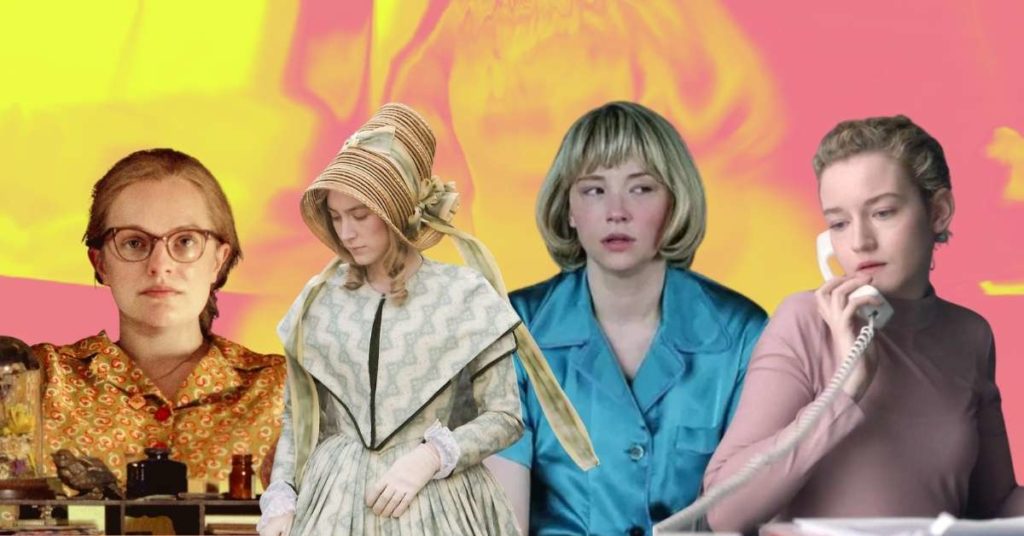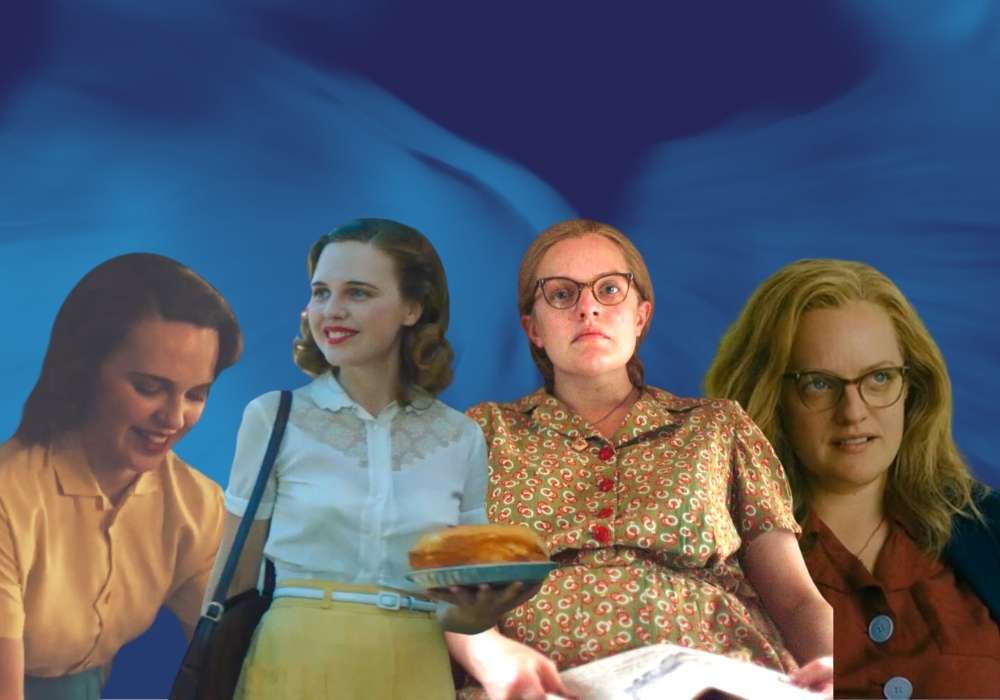We asked four of our writers to pick their favourite costume design of 2020 and write about why they love it. This is part of our 2020 wrap up series.

Discover one film you didn’t know you needed:
Not in the zeitgeist. Not pushed by streamers.
But still easy to find — and worth sitting with.
And a guide to help you do just that.
Although most costume awards are given to period films, that’s often because period costume design is the showiest, prettiest, and most costume design, rather than the best costume design. We love it when clothes build character, sometimes revealing things about a character that remains unsaid in dialogue. That’s the case with all four of the films written about in this article, whether they feature period outfits, old fashioned clothing in a contemporary setting, or if it’s a contemporary film where the main character only wears one outfit for the entire runtime.
We asked four of our writers to wax lyrical about their favourite costume design in a 2020 film. Of course, it’s impossible to pick just one, so before you read their analysis of their picks, here are some honourable mentions. We’ve linked to any coverage we did that talks about the film’s costumes: Animals, Ema, Emma., First Cow, I’m Thinking of Ending Things, Lovers Rock, Proxima, and Sibyl.
Ammonite

Early in Ammonite, 19th-century paleontologist Mary Anning (Kate Winslet) trudges along the stony shores of Lyme Regis, hunting for fossils, dressed in a tattered, blue, checkered dress. When she spots a promising stone on an outcropping of rock, she hitches up her dress, revealing a pair of trousers concealed beneath the skirt. Mary has barely uttered a word thus far in the film, but the layers of her costume convey a woman more concerned with practicality than appearance. She’ll appease patriarchal society by throwing on a feminine outer layer, but underneath, her clothes are functional for the job she loves doing.
Costume designer Michael O’Connor and his team made almost all the clothes in Ammonite from scratch, ensuring that each piece used colour, material, and the wear of the garment to communicate each character’s personality and class. Mary wears four different outfits in the film: a blue dress for outdoor work, an almost identical dress for indoor work, a smart blue dress for social gatherings, and a red dress that she buys at the end of the film for a trip to London. Her limited wardrobe betrays her hand-to-mouth lifestyle, as does the wear and tear of her outdoor dress, which is caked in mud, faded, and frayed. Mary has the clothes she needs to survive and function in society, and nothing more. She only needs one smart dress because she’s something of a hermit — it’s not as if she goes out enough for people to notice repeat outfits.
By contrast, Mary’s aristocratic lover, Charlotte Murchison (Saoirse Ronan), has an array of beautiful, delicate dresses that look ridiculous on fossil expeditions in harsh weather. Charlotte braves Dorset’s angry winds in a corset and a dress that leaves her shoulders exposed. She is all adornments: bonnets, ribbons, parasols, lace, intricately patterned fabric. While Mary is confined to blue, and occasionally red (a colour Lee and O’Connor reserve to connote passion, as was the case in God’s Own Country), Charlotte’s wardrobe is abundant with variety, although her fragility and grief over losing a child is reflected in paler colour choices. Lee’s film leaves a lot unsaid, allowing O’Connor’s costumes to express Mary’s and Charlotte’s melancholy, through muted colours, their connection, through shared instances of red, and the class differences that ultimately leave them worlds apart. Orla Smith
Our interview with the costume designer of Ammonite will be published in March.
Listen to our podcast episode on Ammonite and God’s Own Country.
Read our interview with Francis Lee.
The Assistant

Set over the course of a single day, The Assistant presents Jane (Julia Garner) in a single outfit throughout its runtime, which increasingly reveals itself to be carefully chosen both by Jane and costume designer Rachel Dainer-Best. We first meet Jane in her outerwear: an oversized khaki parka and a large white wool scarf. It’s clothing we’ll start to see as Jane’s armour, which she tucks away in the bottom drawer of her desk. But it also engulfs her, making us aware of how small Jane is even before we see her in the context of her work environment, where she’s belittled, disrespected, and often treated as invisible.
At work, Jane dresses the professional part: sensible, comfortable clothing that’s in muted tones so as not to draw attention to herself. She wears a thin, pale pink turtleneck — covering all of her skin, and making her fade into the background — and black ankle-length slacks with an elastic waist at the back. She pairs these with black boots, a comfortable choice that also immediately fades into the background. While the men (and to a lesser degree, the women) in her office often look right through her as though she’s invisible, Jane has also carefully chosen her outfit to divert their attention. As the film progresses, we sense that this is a defense mechanism in a chauvinistic workplace environment.
Dainer-Best’s choices here are so clever because we understand how Jane chose to dress herself, but the costume choices also signal Jane’s fragility. The pink turtleneck is flimsy and thin, revealing the outline of Jane’s undershirt beneath. It makes Jane look vulnerable despite her best efforts to present a strong and unassuming front. Similarly, while Jane’s work outfit is just fashion forward enough to not stand out, her outerwear is casual, revealing her lower socio-economic status. With her outerwear, she isn’t able to dress for the job she wants, as the saying goes, rather than the job she has.
Although it’s Jane’s outfit we pay closest attention to, Dainer-Best brings the same attention to detail to the supporting characters. Jane’s two male co-workers dress in earth tones, wearing fancier fabrics that catch the light. Like Jane, they dress sensibly in dress shirts and slacks with sweaters rather than blazers, but the blues and greens they wear reinforce masculine stereotypes while the pink of Jane’s turtleneck is a constant reminder that she’s a woman. The young woman who arrives as the new assistant, by contrast, wears slightly brighter colours than Jane: a puffy green overcoat that stops at the hip, and is thus more fitted than Jane’s, and tight blue jeans. The smallness of her clothing belie her vulnerability, while its casualness suggest she’s blithely unaware of how inappropriately dressed she is for the position. Unlike Jane, she does not fit in.
When Jane visits HR (Matthew MacFadyen), he’s dressed in an ill-fitting checkered shirt and a maroon tie. The shirt is slightly too big, giving him a casual look, and the tie suggests that somewhere in his office is a blazer, but he doesn’t see Jane as important enough to wear it for their meeting. His clothes look relatively inexpensive — less carefully chosen than Jane’s two colleagues — and yet he holds such power over Jane. To disarm her, he persuades Jane to take off her coat; she compromises by taking off her scarf. Alex Heeney
Listen to our podcast episode on The Assistant and Promising Young Woman.
Read our interview with Kitty Green.
Read our essay on Matthew Macfadyen in The Assistant.
Shirley

An excerpt from our essay on the costumes in Shirley: “Amela Baksic’s costume design aids Josephine Decker in setting the various moving parts of Shirley, especially its female characters, in rotation around one another. The sun in the centre is Rose (Odessa Young), the protagonist, and the planets that dance around her include Shirley (Elisabeth Moss), Paula (a missing college girl, who is so amorphous, we never even see her face) and the present college girls, who intrude on both Rose and Shirley’s lives (by having affairs with their husbands).
At times, Rose is more aligned with Shirley (who is much older than her) and at other times, with the college girls, who are technically her contemporaries. Rose enters the film in the exact shade of yellow that people tend to paint nurseries when they’re trying to avoid ‘boy’ or ‘girl’ colours. It’s an insipid, bland and entirely non-threatening colour — fitting for Rose seeming like a “good little wifey, good little Rosie” at this early stage. Rose is pregnant and no one knows, except Shirley, who intuits this fact with her “witchy” powers immediately.
Despite Rose being only nineteen, the same age as the college girls, her costuming is more what you would expect from a middle-aged housewife. Ironically, Shirley, who in fact is a middle-aged housewife, does not dress like one. When Rose visits the campus where her husband, Fred (Logan Lerman), works, she passes a tree full of “nymphs” — young, beautiful college girls in bright jewel-tones. They are probably doing something fairly innocuous, like practicing a dance or drama piece, but the way they are shot by Sturla Brandth Grovlen and costumed by Baksic makes them seem much more mysterious and threatening. They are like a coven performing a sacrifice or conjuring curses against Rose. These young women are already a thorn in Shirley’s side and will soon be for Rose, too.”… Read the full essay.
Listen to our podcast episode on Shirley and portraits of female artists.
Swallow

In Swallow, Hunter (Haley Bennett) is a woman coming to terms with the widening gulf between her external persona and internal desires. Richie (Austin Stowell), her husband, views her as a beautiful object that exists solely to adorn his stylish mid-century modern home. Hunter is an accessory, not a partner. For a while, she manages to play the domestic goddess role somewhat convincingly. She drinks her morning coffee in a short, pink silk robe and dons a curve-hugging red cocktail dress for dinner at home. Hunter’s wardrobe is the perfect reflection of her manufactured personality: soft, stereotypically feminine, and inoffensive. While she does a solid job performing her 1950s wifely duties, there’s always something darker lurking beneath the surface. Hunter’s expressed anxiety over doing something “wrong” and disappointing Richie provides a glimpse into some of the deeper issues that she’s trying to mask.
After learning that she’s pregnant, Hunter struggles to maintain this facade of perfection. Her pristine wardrobe starts to show evidence of her internal, thumbtack-consuming destruction. A peach slip dress is marred with a bloodstain; dirt coats her face and clings to the edges of a floral gardening shirt; pockets of a trench coat are filled to the brim with soil. By the end of the film, all beautiful artifice has been destroyed and Hunter is forced to examine herself honestly. When she finally takes control of her life, she’s wearing a loose pair of light wash jeans and an oversized green sweatshirt, a far cry from pearls and slim-fitting cream ankle pants. As she looks at herself in the bathroom mirror, her mouth turns up in a slight smile. What she sees is someone who is ready to slough off her superficial patina and learn to live with what remains. Lindsay Pugh
Read our interview with Carlo Mirabella-Davis.
You could be missing out on opportunities to watch great films at virtual cinemas, VOD, and festivals.
Subscribe to the Seventh Row newsletter to stay in the know.
Subscribers to our newsletter get an email every Friday which details great new streaming options in Canada, the US, and the UK.
Click here to subscribe to the Seventh Row newsletter.




